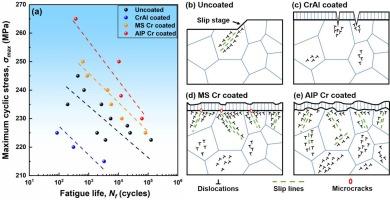Effect of CrAl and Cr coatings on the fatigue behavior of zirconium alloy: In-situ SEM study and CPFEM analysis
IF 6.1
2区 材料科学
Q1 MATERIALS SCIENCE, COATINGS & FILMS
引用次数: 0
Abstract
Accident-tolerant fuel (ATF) coatings were recognized as one of the most promising nuclear materials for short-term commercial deployment, yet their comprehensive impact on the fatigue performance of zirconium alloy substrates remained poorly understood. This study systematically investigated the effects of representative ATF coatings (CrAl and Cr) fabricated through different processes on the fatigue life and failure mechanisms of zirconium alloy using integrated in-situ SEM testing at 400 °C and crystal plasticity finite element modeling (CPFEM). The results revealed that CrAl coatings imposed a deleterious effect on fatigue resistance, while both magnetron-sputtered (MS) Cr and multi-arc ion plated (AIP) Cr coatings demonstrated a significant enhancement in fatigue endurance. The fatigue degradation of coated systems was innovatively categorized into four sequential stages: coating crack initiation, coating crack propagation, substrate crack initiation, and substrate crack propagation. Stage-specific analysis revealed that while brittle cracking in CrAl coatings accelerated fatigue degradation in the zirconium alloy substrate through interface stress concentration, the superior ductility and deformation compatibility of Cr coatings effectively suppressed substrate crack nucleation. A predictive fatigue life prediction framework was formulated through CPFEM simulations, incorporating coating-induced alterations to deformation mechanisms and fracture behavior in zirconium alloys.

CrAl和Cr涂层对锆合金疲劳行为的影响:原位SEM研究和CPFEM分析
耐事故燃料(ATF)涂层被认为是短期商业应用最有前途的核材料之一,但其对锆合金基板疲劳性能的综合影响尚不清楚。采用400℃原位扫描电镜(SEM)和晶体塑性有限元模拟(CPFEM)技术,系统研究了不同工艺制备的具有代表性的ATF涂层(CrAl和Cr)对锆合金疲劳寿命和失效机理的影响。结果表明,CrAl涂层对合金的疲劳耐久性有不利影响,而磁控溅射(MS) Cr涂层和多弧离子镀(AIP) Cr涂层均能显著提高合金的疲劳耐久性。将涂层系统的疲劳退化过程创新性地划分为涂层裂纹萌生、涂层裂纹扩展、基体裂纹萌生和基体裂纹扩展四个阶段。阶段特异性分析表明,CrAl涂层的脆性开裂通过界面应力集中加速了锆合金基体的疲劳退化,而Cr涂层优越的延展性和变形相容性有效抑制了基体裂纹的形核。考虑涂层对锆合金变形机制和断裂行为的影响,通过CPFEM模拟建立了预测疲劳寿命的框架。
本文章由计算机程序翻译,如有差异,请以英文原文为准。
求助全文
约1分钟内获得全文
求助全文
来源期刊

Surface & Coatings Technology
工程技术-材料科学:膜
CiteScore
10.00
自引率
11.10%
发文量
921
审稿时长
19 days
期刊介绍:
Surface and Coatings Technology is an international archival journal publishing scientific papers on significant developments in surface and interface engineering to modify and improve the surface properties of materials for protection in demanding contact conditions or aggressive environments, or for enhanced functional performance. Contributions range from original scientific articles concerned with fundamental and applied aspects of research or direct applications of metallic, inorganic, organic and composite coatings, to invited reviews of current technology in specific areas. Papers submitted to this journal are expected to be in line with the following aspects in processes, and properties/performance:
A. Processes: Physical and chemical vapour deposition techniques, thermal and plasma spraying, surface modification by directed energy techniques such as ion, electron and laser beams, thermo-chemical treatment, wet chemical and electrochemical processes such as plating, sol-gel coating, anodization, plasma electrolytic oxidation, etc., but excluding painting.
B. Properties/performance: friction performance, wear resistance (e.g., abrasion, erosion, fretting, etc), corrosion and oxidation resistance, thermal protection, diffusion resistance, hydrophilicity/hydrophobicity, and properties relevant to smart materials behaviour and enhanced multifunctional performance for environmental, energy and medical applications, but excluding device aspects.
 求助内容:
求助内容: 应助结果提醒方式:
应助结果提醒方式:


